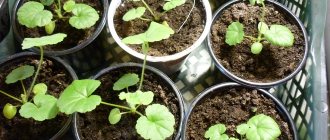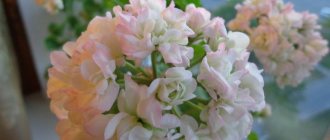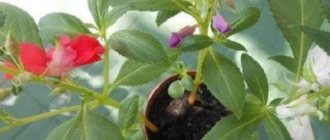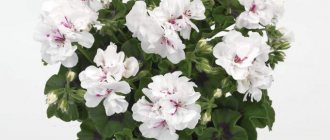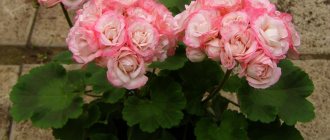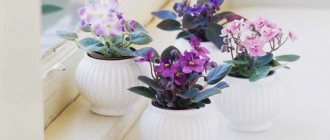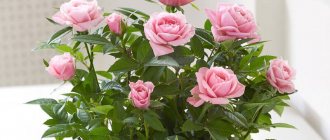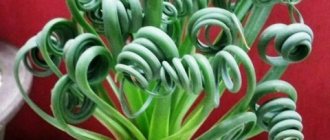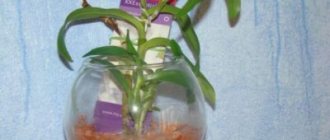Description, history and cost
Dwarf pelargonium is a variety of pelargonium that was obtained artificially as a result of targeted selection. In the process of breeding work, a compact ornamental bush was obtained that does not require molding pruning.
In addition to their attractive appearance, mini pelargoniums have healing properties and a delicate aroma. The smell that flowers emit improves mood and cleanses the air of pathogenic microflora.
You can buy dwarf pelargonium seeds for 125-150 rubles, and cuttings for 300-700 rubles.
Reproduction
Pelargonium Denise - a popular variety
Powerpoint pelargonium is propagated mainly in two ways: by seeds and cuttings. The second method is more common. At the end of February - beginning of March, a stalk with 2 internodes is cut from the plant, dried and placed in nutritious soil. In a month it will become a rooted plant.
Propagation by cuttings
Appearance and features
Dwarf pelargonium is an elegant and miniature bush, suitable for growing in a small pot - about 15 cm. And although the size of the plant is small, it looks very beautiful and impressive. The inflorescences are arranged in groups and form characteristic caps.
Petals can take on different colors, it all depends on the variety:
- red;
- pink;
- white;
- lilac.
The leaves are always dark green or emerald green.
Growing flowers from seedlings at home
The homeland of this attractive and bright flower is considered to be the territory of India and South Africa, thanks to this plant, for real growth and development, as well as strong flowering, a large amount of heat and light is required.
Geranium displays large and attractive flowers from a five-leaved open calyx
It is recommended to grow this herbaceous or semi-shrub decorative perennial in unfavorable regions only indoors or in the classic seedling way for the purpose of subsequent landscaping of the area near the house. Direct sowing into the soil will not be successful.
Common varieties and photos
You can purchase dwarf pelargonium of the following types, look at the photo.
Jinky
The advantage of the variety is large double flowers of light creamy color . At the very core the petals are deep pink. The plant itself is tender and airy, the leaves are light green in color.
Pink Ice
It is a mini bush that is stocky and branchy despite its compact size. The petals are elongated, terry, and pale pink in color.
Read more about Pink pelargonium and its varieties in this material.
Clatterbridge
This decorative crop belongs to the group of zonal dwarf pelargoniums. The peculiarity of the variety is its intense flowering . The buds are terry type and bright red in color.
Silk Moira
The variety is distinguished by salmon-colored petals. It is not picky in care, and the process of forming a bush also does not require much effort.
You can learn more about Pelargonium Silk and its species - Moira, Laguna, Aurora and others, as well as see photos of flowers here.
Madame Maleron
This variety does not bloom at all, but its main advantage is its dark green leaves with a light edge.
Pelargonium seeds obtained from pelargonium flowers
Not all pelargonium flowers produce seeds, but many do. A good time to collect seeds is summer, at which time pelargoniums bloom very well (abundantly). When seeds appear on the inflorescences (flowers), you cannot collect them immediately; you must wait until the inflorescence has completely faded, after which it is cut off with the stalk.
It happens that not all the seeds are ripe; for this, the seeds are placed in a dark, dry place until ripe. As soon as the seeds turn yellow after collection and dry out, they are immediately separated from the calyx and left to dry completely. Large ones are selected from the finished seeds, and empty and small ones can be thrown away.
Landing
In order for the plant to fully grow and develop, you need to know the main features of planting a crop :
- choice of location;
- illumination;
- temperature;
- soil composition.
Lighting and location
In order for the mini-bush to bloom for a long time and beautifully, carefully choose a well-lit place. With sufficient light, the plant will have bright not only petals, but also leaves. If there is a lack of light, the decorative appearance of the flower will fade : there will be fewer inflorescences, and the leaf blade will turn pale.
You need to choose a place for pelargonium so that there is no direct sunlight. At midday, the flower needs to be shaded. In winter, so that the plant does not lose its decorative appearance, it will need additional lighting using lamps.
For the correct formation of the crown, the flower pot should be turned to the window in different directions. Then the sun's rays will be able to reach all parts of the plant, and it will begin to grow evenly.
Soil requirements
Dwarf pelargonium does not have any special requirements for soil composition . It is important to provide the flower with good drainage to prevent moisture stagnation in the pot.
Soil with a neutral or slightly alkaline reaction is best suited for the plant. If the soil is acidic, then it is necessary to add ash to it.
To prepare the soil mixture, you can mix the following components in equal proportions::
- humus;
- leaf soil;
- turf;
- river sand.
Growing pelargonium from seeds
Propagating pelargonium from seeds is considered the most profitable. Pelargonium seeds have very good germination; when sowing eight seeds, only one seed may not germinate, but all the rest will germinate, and they germinate already on the fourth day. They begin to bloom after sowing in the fifth month. Pelargonium seeds are somewhat similar to wheat seeds in their shape, but only half the size. The shell is covered with dense skin.
Plant seeds all year round, but do not forget to illuminate in winter and autumn. Of course, it is best to plant in January or February. Before sowing from the beginning, the seeds are ground with sandpaper (fine-grained or fine) to remove hard scales and to break the integumentary membrane - this method is called scarification. Then the seeds are soaked for four hours in clean water or placed in a damp cloth, gauze, and planted.
Home care
Temperature
In summer, dwarf pelargonium prefers to grow in moderate temperatures - 17-23 degrees Celsius. Overheating must not be allowed. In winter, the optimal temperature remains 12-13 degrees, but not higher, since during this period the flower rests.
Watering
Dwarf pelargonium responds positively to soil moisture, so you need to water it regularly and abundantly. In summer, moisturizing is done every other day, and in winter – once a week. It is important to ensure that the soil dries thoroughly before watering .
It is not necessary to spray dwarf pelargonium, as this procedure injures the leaves and flowers.
Top dressing
The plant must be fed regularly, especially during the growing season - from March to November. In winter, the plant does not require additional nutrition, as it rests.
Phosphorus or potassium should be used as fertilizing , and it is important not to overdo it with nitrogen. If this element is in excess, the green mass will begin to grow actively, but flowers will not form. Complex fertilizers must be applied once every 2 weeks.
Molding
In order for the bush to be lush, it is necessary to regularly pinch out young shoots. This manipulation will enable the plant to form a large number of lateral branches, as a result of which the decorative appearance of pelargonium will improve.
Sometimes the shoots become very elongated during the winter, so in the spring they have to be removed by 1/3 of their growth. If the cuttings are healthy and strong, they can be rooted. Then there will be even more beautiful and graceful pelargoniums in the house.
Optimal timing
There are no clear recommendations when to plant pelargonium, since geranium from seeds is not particularly picky about growing.
Florists advise doing this in the spring-summer season, when there is the greatest amount of sunlight. Some gardeners claim that it is best to start sowing in March, then by July the geranium will delight you with flowering. Others are inclined to November-December, arguing that grains can be germinated under artificial light, but natural light is well suited for seedlings.
If you don’t want to wait for warmer weather, it doesn’t matter. You can use additional lighting from electric lamps and grow seedlings all year round. Geranium will grow to medium size within 3-5 months.
Diseases and pests
The most common pests that attack dwarf pelargonium remain:
- aphid;
- spider mite;
- whitefly
To combat parasites, it is necessary to use the following drugs: Aktara, Confidor.
Dangerous diseases include:
- Black leg . This is root rot, which occurs as a result of excessive soil moisture and insufficiently high air temperatures. There is no cure for blackleg, so the affected plant must be disposed of immediately. The soil that remains in the pot must also be disposed of.
- Swelling and rotting of leaves . A pathological process occurs as a result of excessive watering. And at low temperatures the foliage begins to turn red. To prevent this, it is necessary to move the pot away from the window glass on frosty days.
- Stretching and exposing stems . Occurs as a result of lack of light. To solve this problem, you need to place the flower pot in a well-lit room. If there is no flowering, it is because the air temperature is too high during wintering.
How to sow seeds: step-by-step instructions
Scarification and stratification are not needed for pelargonium seed material. Fresh and high-quality seeds can sprout quite quickly even without prior preparation.
You need to check the labeling on packages of purchased flower seeds. Seed material must be of high quality, full-bodied, and free of debris.
How to properly grow pelargonium from seeds:
- Soak the seed material in a growth stimulator such as “Epin” or in warm water.
- Fill the seedling containers with ready-made, fairly dense flower soil, warmed to room temperature.
- Spread the seeds over the surface of the soil, lightly press them down and spray them with a spray bottle.
- Cover the container with a transparent lid or film.
Preparing soil for sowing seeds
- first method - Take some kind of dish or box so that there are holes at the bottom to drain excess water. Place finely chopped polystyrene foam, about one centimeter, on the bottom of the dish. After the polystyrene foam, take sand, mix it with peat approximately one to one and thoroughly moisten it. Do not forget to disinfect the soil before sowing pelargonium seedlings, because seedlings are very quickly susceptible to the “blackleg” disease. You can use potassium permanganate, the solution should be pink, you can also use a solution of the biofungicide “Fitosporin - M” - the second method - Take one proportion of sand with peat and add two proportions of turf soil. Before sowing, be sure to disinfect the soil.
The seeds should not be deeply buried, three millimeters above is enough, they must breathe, and they must have enough oxygen during germination. Then they are sprayed with a spray bottle, covered with glass (every day the seedlings are ventilated and the glass is wiped from condensation) and placed in a bright place, but not in direct sunlight (with good lighting, pelargonium seedlings grow stocky and strong). The temperature should be between eighteen and twenty-four degrees Celsius. The plant should not be flooded. After eight days, the sprouts sprout. When three to four weeks have passed, pelargonium seedlings are transplanted into another container or pots - this is done by picking
Plant the plant at the same depth at which it grew - this is very important. You can also plant seedlings in peat tablets
To begin with, scald the peat tablet with boiling water, let it cool and begin to transplant one seedling onto one tablet and into a separate pot. After planting, the pots are covered with glass or transparent film to strengthen the roots. The temperature should be approximately seventeen to twenty-one degrees Celsius. We also do not forget to disinfect the soil, you can use “Fundazol” per one liter of water, one teaspoon, stir well and water the pelargonium along the edge of the pot. Then pinch on the sixth leaf to give the plant plenty of fluff. A lot of fresh air and light contributes to the constant flowering of pelargoniums and good growth.
What kind of flower is this?
Pelargonium is a herbaceous semi-shrub flower. There are already more than 400 varietal varieties around the world. The name comes from the shape of the fruit, which was similar to a crane's beak. The first species were identified in Africa. The pleasant smell and neatness have been loved since ancient times, and after that they began to appear in every home. Popularity arose due to active growth and unpretentious care. In warm climates, the plant lives in the garden, as the height can reach large sizes. Read about garden pelargonium, as well as how it differs from geranium, here, and you can learn about hanging varieties in this article.
